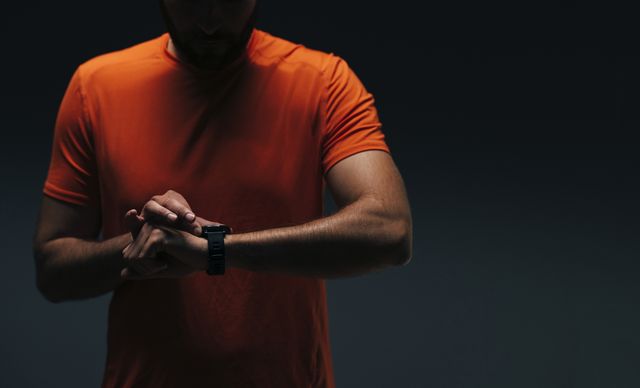There's no denying the Apple Watch's popularity when it comes to fitness tracking. "Closing the rings" has more than entered the zeitgeist, and the crossover capabilities from training to everyday life are seemingly never-ending with each subsequent software update.
While Apple has definitely made it easier and more enjoyable to monitor our workouts — especially with this week's watchOS 10 updates adding high-tech new features for activities like cycling, hiking, golf and tennis — what about watch wearers who take their training with a bit of iron?
For those who favor strength training over other fitness disciplines, the ability to track your workouts with an Apple Watch is a little less intuitive. But don't think you have to abandon your digital companion every time you lace up your gym shoes. With a little bit of digging — or a few minutes spent in the app store — you can train as hard as you'd like while still keeping proper records of your reps and sets. Here's the skinny on how you can utilize your Apple Watch for any strength training routine.
Why Log Your Workouts in the First Place?
Keeping receipts of your training can have multiple benefits, especially in regards to weightlifting. For one, keeping records of your lifted loads can help you easily progress as your muscles grow and get stronger. The ultimate goal in any muscle-building exercise is to lift more than you previously could, so why not keep tabs on your progress through proper documentation?
Secondly, a detailed workout log can allow you to easily plan out your time in the gym. A good comparison would be a grocery list. If you already know what you plan to buy — or in the gym space, which exercises you plan to hit — the entire experience can go much smoother.
Finally, keeping a workout log can serve as a secondary source of motivation, especially in less than ideal lifting situations. If you get a little down on yourself because you missed that last squat rep, all it takes is a quick scroll to realize your one-rep max is still pounds above where you started. This boost of positivity can be more vital to your continued training success than even the most skilled spotter. After all, fitness is not always about the end result. Sometimes, reflecting on the progress is enough to maintain motivation.
Doesn't the Apple Watch Already Have "Strength Training" Workouts in WatchOS?
Yes, but there's a big big catch: The data recorded is still in line with other workouts offered in the WatchOS service, meaning only your calories, time and BPM are measured as you lift.
Tracking your BPM and calories burned are important to a fitness regimen, especially for those looking to manage their weight. However, if you're looking to monitor your reps, sets and weight lifted, you can't solely rely on the Workout app.
If you are interested in tracking your calories and other traditional metrics during your strength training sessions, there are a few methods to do so, which vary depending on your watchOS system. For athletes running watchOS 7 and newer, you can choose between Functional Strength Training modules for exercises involving bodyweight movements or small accessories like dumbbells or resistance bands. You’re also able to Add a Workout and choose Traditional Strength Training for sets more attuned to common lifting exercises like the bench press or deadlift.
WatchOS 6 and older users aren’t left in the dust entirely, but there’s a little more involvement across the aging platforms as you need to add a workout manually — there are no pre-set traditional or functional modules from which to choose.
The App-Free Solution: Voice Memos
Despite the lack of trackable capabilities with Apple Watch's Workout app, you can still record your performance with software already included in WatchOS. If you already have a good understanding of your training regimen, you can easily record your lifted totals through Voice Memos. This allows for seamless data collection that doesn't require you to type out sets or statistics. Simply open Voice Memos, speak your totals, and end the recording.
You can then log your sets once your workout is complete by playing back the recordings from your training session. This does take a little more dedication to tracking, and doesn't give you an immediate point of reference for past lifts, but the voice recording feature can be easier than toting a traditional pen and paper around the gym. Additionally, Voice Memos can be streamed to your iPhone, allowing you to securely keep tabs on your day's performance.
Need More Guidance? Try Third Party Apps
If you're not interested in speaking into your watch, transferring the recorded data to your Notes tab and shuffling between your watch and iPhone to see what your previous totals were, there still is hope. With third party apps, you can keep tabs on your reps and sets without having to master a spreadsheet post-workout. There are varying levels of intricacies, depending on your fitness needs. Below are three picks that can suit your strength training style.
Editor's Note: The prices shown below are for yearly subscriptions.
Fitbod
If you're brand new to the gym circle, Fitbod can be a great tool to get you comfortable with the exercises and modalities. This third party app can sync with your Health app for a streamlined collection of all your data points in one convenient spot. Also, if you aren't as comfortable with a particular exercise, like say a Romanian deadlift, you can exclude the modality from the library for an easier app experience.
Gymaholic
With a number of pre-programmed workouts and exercises to choose from, Gymaholic provides plenty of resources to boost your training regimen. Track your lifts, reps and sets alongside your calories and heart rate for a detailed look at just how much you're pushing yourself in the gym. The most convenient feature, though, is the haptic alert that notifies you when your intended rest period is up. Intermediate strength training enthusiasts should understand the importance of timed rest in-between sets, and this component helps you maintain that intense yet efficient schedule.
Strong
For those individuals more versed in drop sets, RPE and other strength training terms, Strong is our recommendation for logging your fitness journey. This app allows you to manually curate your workouts and can track reps, sets, weight, body fat percentage and more. Strong also works with the Health app for more streamlined data collection, making it exceptional for those dialed in on their metrics.
The Apple Watch is a premium fitness tracker that can easily monitor your performance across a number of disciplines. While there's no denying its efficiency in running, yoga or other calorie-burning modalities, it can be just as effective under the barbell, too. With these tips, you can hopefully unlock that digital gym partner your workouts have been missing.
Convinced your strength training regimen needs an Apple Watch now? The Apple Watch Ultra is probably your best pick for athletic-minded scenarios, but you can unlock all the tracking potential above with any of the brand’s latest releases.




























